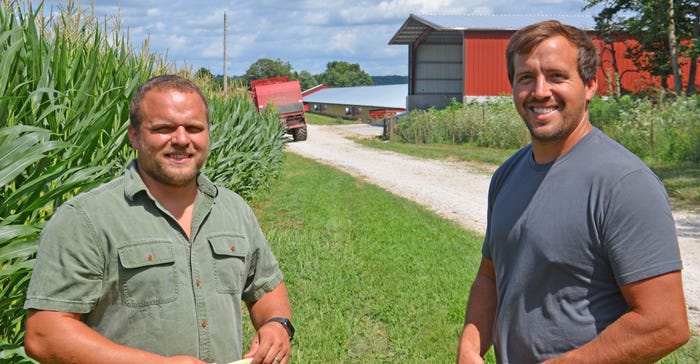
Michael and Kelsey Gettelfinger grow crops and do it well. Their operation is about 95% no-till and uses cover crops. Their dedication to conservation has already earned them recognition as outstanding conservation farmers.
But right now, another facet of their business is helping everything cash-flow. The Gettelfingers are in the poultry business, and about a year ago, they began producing eggs in a contract operation. By using their own labor and hired labor in the off-season, and providing manure to help reduce fertilizer bills, they believe the poultry operation complements their cropping operation very well.
“Our father, Steve, passed away, and when I started farming, we only farmed about 350 acres,” Michael recalls. “Livestock was a way to diversify and add income, so I invested in the first three poultry houses in 2012.”
Crop acreage has expanded several times since then, and the Washington County, Ind., brothers hope to continue adding acreage. In the meantime, the poultry enterprise has not only grown larger but also shifted directions.
“I came back to the farm in 2012 from Purdue University,” Kelsey says. “We added three more poultry houses in 2014.”
Michael adds: “We raised broilers until 2019 on contract for a national company. Then we had the opportunity to switch to laying hens through a local company.”
Michael and Kelsey decided to make the switch for a couple of reasons. Their contract to raise laying hens and produce eggs is through River View Farms, based at Orleans, Ind.
“We enjoy being able to work with a local company,” Michael says. “If I need to talk to the owner, I can. The more personal relationship is a real plus.”
So is the regular paycheck for the eggs they produce, Michael says. They provide the buildings and labor, and River View Farms provides the birds and feed. The Gettelfingers receive payment for their eggs weekly. They note it’s a big help on cash flow.
Big switch
Making the conversion from broilers to laying hens wasn’t as easy as just deciding it was a good way to improve cash flow and work with local people. The broiler barns all had dirt floors. Converting to laying hens meant pouring lots of concrete and building an egg-handling facility.
“We poured 3,300 yards of concrete last year,” Kelsey says. “We did quite a bit of it ourselves, with help from our uncle Chris Gettelfinger. We did enough that I know I don’t want to be in the concrete business to make a living!”
Looking to the future, River View Farms asked the Gettelfingers to install equipment for cage-free hens. “It’s going to be the way of the future, because people are demanding it,” Michael explains. Each building is divided in half. Hens can move freely within their half of the building.
Eggs are collected by conveyor belt and brought into a central building. Workers place them in cases. The cases are then placed on pallets. Each pallet holds 10,300 eggs, and a truckload of pallets holds just under 300,000 eggs. When hens are in full production, several truckloads leave the farm each week for a processing facility operated by River View Farms. That’s where eggs are placed into retail cartons and sent to their final destinations, sometimes several states away.
Their younger brother, Nathaniel, also works for them full time in the operation. “The poultry business is seven days per week, just like dairying,” Michael says. “So far, it’s working well for us.”
About the Author(s)
You May Also Like




